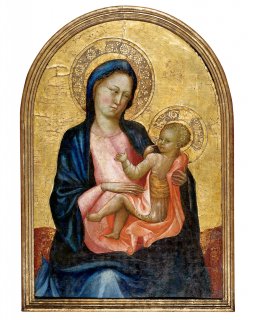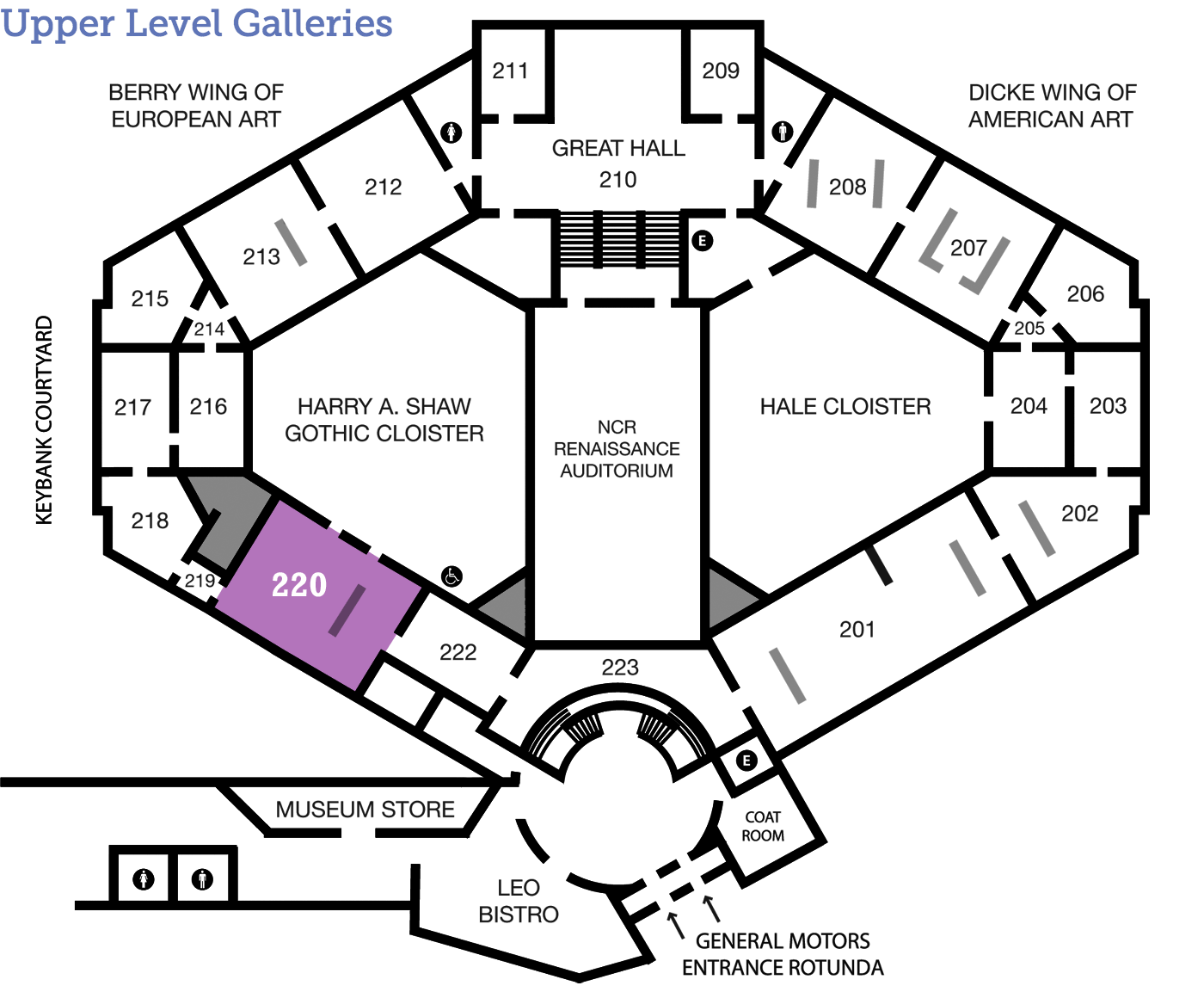
Giovanni Francesco Toscani
Madonna of Humility
(1370–1430)
Italian c. 1410 Tempera and gold leaf on poplar 26 ¾ x 18 ¼ inches Gift of Mr. and Mrs. Elton F. MacDonald 1957.142
A Mother's Love
The Virgin Mary holding the infant Christ child was a popular subject in European art for centuries. Paintings like this, often referred to as “Madonna and Child” paintings have given hope and comfort to generations while simultaneously projecting an ideal image of womanhood.
A Day in the Life
Art in a Time of Crisis
Madonna of Humility was painted around 1400, but its static, flat depiction of space and the figure seems to refer back to an earlier time, before many of the innovations of the early 1300s that revolutionized the way artists approached these issues in their work. Why might this be? In the early 1300s the city-states of Florence and Siena were economically prosperous, politically stable, and artistically creative. However, a series of crises hit mid-century. These included economic crises—such as bankruptcies in the banking sector—and food shortages from poor harvests. Most drastic was The Black Plague in 1348, which killed over half of the populations of the cities. It would strike again in 1363 and 1374. These events were often viewed as divine judgment, so in response there was a renewal of religious fervor. This contributed to the emergence of patrons who were not as interested in earlier artistic innovations and preferred more traditional ways of depicting religious art.
Further Reading: Millard Meiss, Painting in Florence and Siena after the Black Death (Princeton, NJ: Princeton University Press, 1951).
Tools and Techniques
Leaves of Gold
Look closer at the background of Madonna of Humility. Is that gold paint? Actually, it is real gold. Gold is very malleable and can be hammered into paper-thin square sheets called gold leaf. The delicate task of applying gold leaf is called gilding. Gilding allows artists to create the overall finish of gold without using too much of the costly material. See it in action, along with other processes that went into making a panel painting, in the following video from the Getty Museum. Then, look closer and see if you can find any traces of the gold leaf sheets, or possibly where they overlap, in the background of this painting.
© Getty Museum
Behind the Scenes
Look Closer
Egg Painting
Would you paint with food? The main figures in this painting are made with tempera paint, which uses eggs. How does it work and how is it different from oil paint? Learn more about the unique qualities of both in the following video from The National Gallery in London. Then look at other paintings in Gallery 220 and see if you can identify which use tempera and which use oil.
The National Gallery, © 2014
Transcript:
The appearance of a painted color depends partly on the pigment, but also on the ingredients used to bind the paint together. Pigments mixed with oil produce a glossy finish. Pigments mixed with egg yolk to make egg tempera paint will have a flatter, matte appearance.
Pigments made from mineral clays, known as green earths, bound in egg tempera, were used by Italian artists from the 13th to 15th centuries as a base color for flesh. These greens were used to suggest shadows and model the shape of the face. Pinks, reds, and white highlights were added on top. Tempera dries so quickly that different colors can’t easily be blended on the painting surface, so artists use delicate hatching when applying the different colors. The very green skin tone of many Renaissance faces may be due to the layers of pink paint having faded, revealing more of the base layer than was intended.
With oil paint, the pigment is bound in certain kinds of oil—often linseed or walnut—that dry to form a tough film. Jan van Eyck was particularly famous for his skill at working in oil. Oil paint dries slowly, and so can be manipulated on the picture surface. Some pigments are opaque, others can be used to make a translucent glaze. Glazes can be built up in layers to produce a deep, glossy color that can imitate gleaming satins, costly wool, velvet, and rich silk damask.
Just for Kids
Look!
Paintings of Mary holding baby Jesus were popular in Europe during the Middle Ages. Look how Mary holds her baby. Is this different from how you see other mothers holding their babies? Look around the museum. Can you find other artworks that show a woman holding a baby? How are they similar to Mary and the baby Jesus? How are they different?
Signs & Symbols
Reading a Painting
How can you tell this is the Virgin Mary and the infant Christ child and not some other woman holding a baby? Religious art often gives special meanings to particular colors, poses, and gestures. The process of interpreting these conventions is known as iconography. Sharpen your iconography skills by tapping on the different points below to reveal what they mean.

Dig Deeper
Arts Intersected
The Sculpture Speaks
Did You Know?
Expert Opinion
Look Around
Different Faces of Devotion
Painting went through rapid changes in Italy from the 1300s to the 1500s, the time period often referred to as the Renaissance. The Madonna of Humility is from the early 1400s, and it still contains elements of the earlier Byzantine style where figures are relatively flat and often appear on a gold background.
As artists experimented with new ways of depicting the human form, especially in light of renewed interest in ancient Greek and Roman art, figures take on greater solidity, shape, and expression. You can begin to see these changes in the Madonna of Humility; for example, the faces are more naturalistic compared to the hands, and there is more interaction between the figures. But compare this to Pier Francesco Bissolo’s The Holy Family with a Donor in a Landscape, made approximately one hundred years later. Note that the Toscani painting is made with tempera paint while the Bissolo painting is made with oil paint (see “Look Closer”). What other differences can you see? Do the background settings make the figures appear more idealized or humanized?
About the Artist
Talk Back
Seeing Gender
Compare the Madonna of Humility with other ways you see women depicted in artworks in The DAI’s permanent collection. How has this changed over time? Do you perceive some changes as more affirmative than others? How do they compare with images you see of women in popular culture today?

